by Paul Dufresne
In Part 1 I discussed how the Endotapping technique could disrupt the fear/excite (Adrenaline) cycle in the horse and replaced it with a deeper state of relaxation through a neurohormonal release of Endorphins. In Part 2 I showed how to develop some good relaxation cues by combining Endotapping with a head down position and controlling the bend, at a halt, walk and trot. Then in Part 3, I explained how to move into other important foundation skills such as bomb-proofing. As you develop good relaxation cues and while preparing for bombroofing, you continue to improve the yields and establish yourself as a good leader. The next step is to use these relaxation cues to set up a positive shape and then ask the horse to improve its way of moving. I’ll explain this by giving you an example of improving the quality of the walk.
I start by asking the horse, at a halt, to bring its head down and relax by tapping it in zone 1. This is the ribcage area where my leg would hang while riding. You could also check to see if you get the same positive response by tapping zone 2 on the neck. If the horse easily relaxes with its head down you are good to go. If not, keep tapping and gently put downward pressure on the halter until your horse relaxes the poll and lets the head hang plumb (90 degrees-perpendicular) without tension. Once the horse has this response reliably, you can get your horse to move forward. As the horse walks forward I encourage it to carry the head below the level of the withers with it hanging loosely from the end of its neck. Should the horse bring its nose up and forward (starting to invert) just remind the horse to relax by tapping and adding a slight downward pressure on the halter. Circling with a correct bend while tapping will also facilitate the relaxation and release of the poll.
When the horse is traveling on a circle with proper bend and relaxed poll, I can then look at its footfall. I will observe where the hind foot tracks in relation to the fore foot on the same side. Ideally we would like the horse to have a loose enough topline that they can at least track up to the print of the front foot. It is always valuable for the horse to be relaxed enough to overreach, or step the hind foot past the print of the front foot.
When I have the bend, the poll and my horse traveling in a nice relaxed state, now I can use my whip to tap the horse just in front of the groin area with a slightly sharper tap. The tap is timed to coincide with the rear leg leaving the ground. Tapping on the belly at this moment will cause a stronger contraction, raising and drawing that hock further forward. If I were to tap every 3rd - 5th stride on that side, I would start to see the horse increasing the length of its stride. If the horse gets a bit worried and wants to bring its head up, simply tap normally and relax it back to the starting position with bend and the soft poll before asking for more stride.
The really cool thing about this technique is that even if you miss the timing with the intended leg, and tap in time with the opposite hind leg, you will still cause the desired effect of lengthening the stride.
People often don’t realize that some anxious horses spend their whole day in movements that tighten up the topline which inadvertently shortens their stride. As an example, my Andalusian stallion constantly walks the fence any time horses move place on the farm. He jacks his head up to watch as he repeatedly does walk to roll-back - sometimes for much longer periods than is healthy before I can stop this destructive pattern. If I was away at clinics and he wasn’t ridden regularly, I was amazed at how short his stride would become. In about four sessions of relaxing him and focusing on keeping him relaxed, I was able to get 6-8 inches of over-reach where previously he had been short of capping. As I focused on improving his stride the constant reminder to tap him and keep him relaxed also reduced his anxiety level.
You could ask the horse to do the dime exercise (standing with all four feet almost together) and push forward by tapping just in front of the groin area. Drive from the rear without pulling the head forward. You could also elevate the horse’s head and ask the horse to move away with 1-3 steps of Quartering and then tap again in front of the groin area to push forward. With these combined exercises I have never seen a horse fail to improve the length of its stride and achieve a higher degree of relaxation. A big stride that is more relaxed is more efficient. It requires less energy to travel farther with every step.
The same procedure can be done at the trot. Start with the softest JOG your horse can do. Once you have the soft jog with a head/neck long and low while relaxed, tap just in front of the groin area to increase the stride. When the horse holds a good posture with a totally relaxed back then we can engage the ring of muscles to push from behind into a bigger stride. Keeping the horse in a relaxed shape will allow for more athletic movement and agility.
Next issue I will discuss how to develop the canter similarly and how to adapt this technique to riding. Keep your horse in a relaxed zone and then ask it to improve athletically you will both enjoy it more.
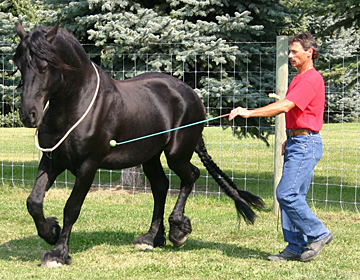
Ljibbe showing a collected trot. The whips tap in Zone 2 (neck area) to ask for the shape.
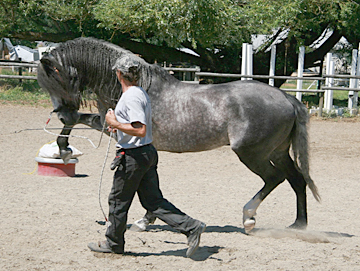
Padrino shapes up and pushes into a Spanish Trot.
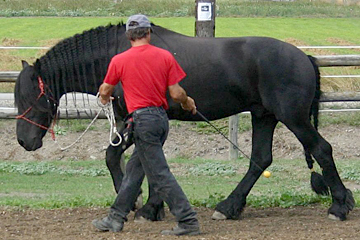
Ljibbe at a walk. I'm preparing to tap just in front of the groin area.
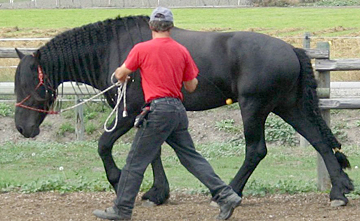
The tap lingers on the groin area after the tap has brought the hind leg further forward.
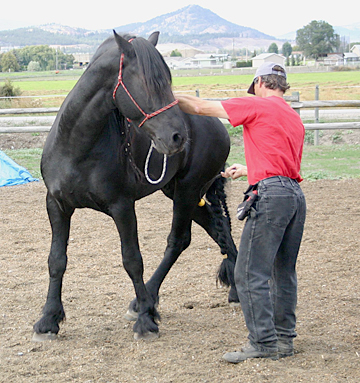
Ljibbe quartering on the bend. I'm tapping the groin area to help the hind leg cross under further.
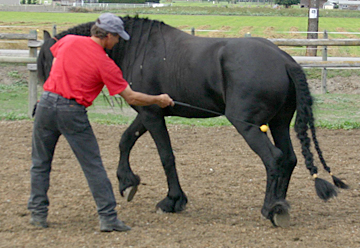
Ljibbe pushes forward out of the quartering. I encourage the push by tapping the hamstring. This can also be done out of a Dime position.
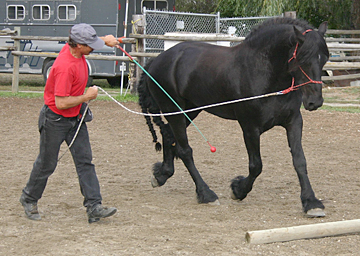
Ljibbe shows a nice shape to the trot.
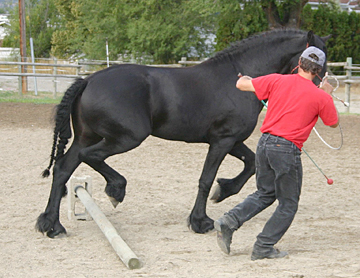
Nice form over the cavaletti.
trainers and clinicians modify techniques to suit their needs, and the needs of their students - both human or equine. This
technique, when combined with shape control and Natural Horsemanship, I have found to be an exceptional
way to lead a horse and facilitate a very healthy partnership.